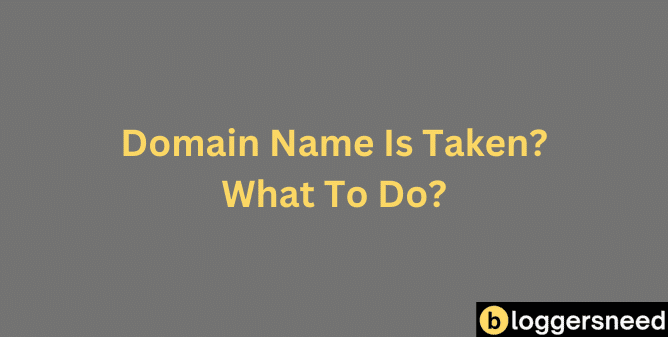
Discovering that your desired domain name is already taken can be frustrating, especially when you’ve envisioned it as the cornerstone of your online presence. But don’t worry, you have several strategies to explore. You can negotiate with the current owner, consider creative variations of your name, or look into different domain extensions. Utilizing domain name generators can also inspire new and unique options. Understanding these options and potential legal considerations will guide you towards finding the perfect domain for your brand.
Table of Contents
What Is the Domain Registration Process?
The domain registration process involves several key steps that allow individuals or organizations to secure a unique web address for their online presence.
First, you need to check if your desired domain name is available. Use a domain search feature on a registrar’s website to see if your domain name can be registered.
If it’s available, you can proceed to register it by creating an account and completing the registration process.
If the domain name is taken, you have various options, such as choosing a different domain extension, modifying the domain name, or purchasing the domain from the current owner.
Why Might a Domain Be Unavailable?
If your desired domain name isn’t available, it means someone else has already registered it. Typically, domain names are registered for one year, and they can become available again if not renewed.
Some domains are used by businesses or organizations to protect their brand or redirect traffic. Others might be parked, displaying ads but not actively used.
If the domain you want is registered, you can try checking the expiration date using WHOIS tools and register it when it becomes available. Alternatively, you can consider a different top-level domain or add a word to your desired name, like from flowershop.com to customflowershop.com.
Waiting or negotiating a purchase are other options, though the process can be complex and costly.
What Options Are Available if Your Domains Are Already Taken?
If your domain name is taken, you may consider contacting the current owner to see if they’re willing to sell it to you.
Alternatively, think about using variations of your desired domain name by adding a prefix or suffix, or experimenting with different top-level domains (TLDs).
1. Contacting the Current Domain Owner
Reached the point where your perfect domain name is already taken? You have options.
Start by researching the domain’s availability and conducting a quick Google search to gauge its current use and visibility. Use a WHOIS database to identify the domain owner and contact them with a friendly, professional email. Avoid mentioning the price initially.
If the owner responds with a figure, assess it against your budget and counteroffer if necessary. Be patient; negotiations can take time.
If direct contact is challenging, consider hiring a domain broker who can navigate complex discussions and negotiations. They typically charge a percentage of the sale price, around 10-15%.
Keep your communications professional and guarantee legal and escrow services are involved to secure the transaction.
2. Considering Domain Variations
Facing a taken domain name doesn’t have to be a dead end. You can explore different domain variations to find a suitable alternative.
Start by modifying your keywords or brand name. Use prefixes like “Get,” “My,” or “The” before your brand name, such as getbrandname.com or thebrandname.com.
Alternatively, you can use shorter forms of your brand name, like an abbreviation or a hyphenated version.
Consider using different Top-Level Domains (TLDs) like .net, .org, or country-specific domains (ccTLDs).
Additionally, you can purchase domain extensions that describe your business, such as .pizza or .actor, to enhance your branding and SEO.
3. Brainstorming Entirely New Domain Names
When your desired domain name is taken, brainstorming entirely new domain names becomes the next logical step.
Start by using domain name generators like Wordoid, Looka, and Nameboy to inspire new ideas. These tools can help generate unique and available domain names based on your keywords and brand-related words.
Keep your domain name short, memorable, and avoid hyphens and numbers for better recall and user experience.
When selecting a new domain, verify it reflects your brand name or purpose and check availability across social media platforms to maintain consistency and avoid potential legal issues.
What Steps Can I Take To Avoid Domain Squatting and Cybersquatting?
To protect your domain from squatting and cybersquatting, register your domain as soon as you identify it.
Purchase variations of your domain name, and set up automatic renewal.
Additionally, register your trademark to establish legal rights, and consider domain ownership protection services.
If a domain is already taken, negotiate with the registrant or file a UDRP complaint.
How Does Trademark Law and Udrp Affect Domain Ownership?
Maneuvering the complex landscape of domain ownership involves understanding how trademark law and the Uniform Domain-Name Dispute-Resolution Policy (UDRP) play critical roles.
If a domain name infringes on your trademark, you can file a trademark infringement lawsuit. Under UDRP, you can dispute the registration of the domain name if it was taken in bad faith to profit from your trademark. This process typically costs between $1,500 and $4,000 and is resolved within 60 days.
Simply, if a domain name uses your trademark without authorization, you can seek legal action to claim it back and potentially receive damages. Always consult a lawyer experienced in domain name disputes.
What Legal Actions Can I Pursue Against Bad-Faith Registrations?
If your domain name is taken by someone using your trademark in bad faith, you have several legal options.
You can file a Uniform Domain Name Dispute Resolution Policy (UDRP) complaint. To succeed, you must show that you own the trademark, the registrant has no rights to the domain, and the registrant acted in bad faith.
The UDRP process is quicker and less expensive than a lawsuit, typically resolving within 60 days for $1,500 to $4,000.
Alternatively, you can file a trademark infringement or cybersquatting lawsuit, which may result in transferring the domain name and awarding monetary damages.
What Are the Frequently Asked Questions About Domain Name Unavailability?
Do Domain Registrars Steal Domain Names?
No, domain registrars do not steal domain names, but domain theft can occur when hackers illegally transfer a domain to another registrar without the owner’s consent, often through phishing or exploiting security vulnerabilities
Can My Domain Name Be Taken Away?
Yes, your domain name can be taken away if you fail to renew it, violate the registrar’s terms of service, or if it infringes on someone else’s trademark rights, which can lead to legal disputes.
Can You Buy a Domain Name That’s Already Taken?
No, you cannot buy a domain name that is already taken by someone else, as domain names are unique identifiers for websites and must be registered with a domain registrar to be used.
Can You Have Two Websites With the Same Domain Name?
No, you cannot have two websites with the same domain name because each domain name is unique and points to only one website on the internet.
Should I Register Domains for Future Use?
Yes, you should register domains for future use to protect your brand and ensure that no one else can claim them, especially if you have plans to expand your business or create new projects later on.
Should I Register My Domain Across Multiple TLDs, and Why?
Yes, you should register your domain across multiple top-level domains (TLDs) to protect your brand from cybersquatters and competitors who may try to register similar domains, and to ensure that your website is easily accessible to users regardless of the TLD they type in
What to Do If Your Domain Name Is Available?
If you find that your desired domain name is available, there are several important steps you should take.
- First, you should quickly register the domain name to secure it. Here is the best registrar for domain.
- Next, you need to decide how you will use the domain, such as for a website, email, or online business.
- After that, you can start building out your online presence with the new domain. It’s also important to protect your domain by keeping your registration information up-to-date.
- Finally, you can promote your new domain name to attract visitors and customers
Affiliate Disclosure: Some of the links in this post are affiliate links, which means I may earn a small commission if you make a purchase through those links. This comes at no extra cost to you. Thank you for your support!
